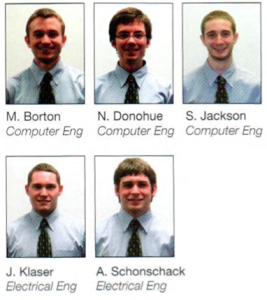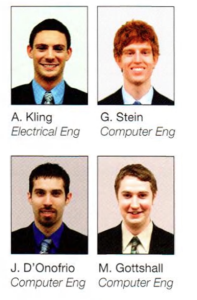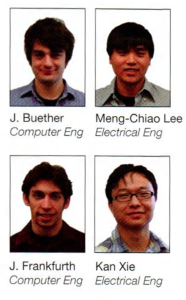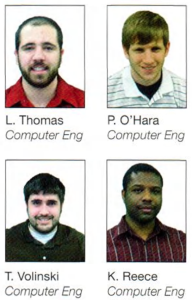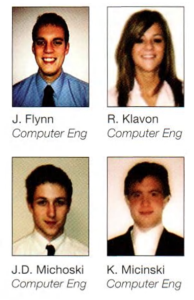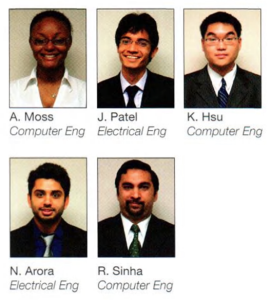Electrical Engineering
Projects
Electrical and Computer Engineering ECE 480 Senior Design is required of all electrical and computer engineering majors at MSU.
For information on becoming a project sponsor, please contact Gregg Motter.
The following are the project sponsors and projects for the spring of 2011:
Dow Chemical Company: Internet-on-Demand for Rural Schools in Tanzania
 Our team is continuing on an ongoing project to bring computers and internet capability to rural schools in Tanzania. Enrollment in schooling has steadily increased in the past several years, but without funding to purchase text books, other methods have to be exploited to get learning materials and information access to these rural areas. One idea has been to provide internet access to the schools. Previous ECE 480 teams have installed solar-powered computer systems at several schools in which one school is directly connected to the Internet by satellite, and the other schools connect to the main school through a wireless network to access the Internet. Electricity is expensive and must be conserved; therefore, when no schools are using the Internet, the satellite and other equipment are to be turned off. Our team’s goal is to implement an Intemet- on-Demand solution to allow two different schools to access the internet via the satellite and WiFi/WiMax channels at Baraka Primary School. In our proposed approach the remote schools will request Access-to-Internet by sending encoded radio signals to Baraka; the received signal at Baraka is processed by a microcontroller (PSoC) to determine the identity o f the school requesting access, and subsequently turns on the satellite access hardware and the communication channel for that school. If no requests are received for a specified interval of time, the PSoC will power off the internet equipment.
Our team is continuing on an ongoing project to bring computers and internet capability to rural schools in Tanzania. Enrollment in schooling has steadily increased in the past several years, but without funding to purchase text books, other methods have to be exploited to get learning materials and information access to these rural areas. One idea has been to provide internet access to the schools. Previous ECE 480 teams have installed solar-powered computer systems at several schools in which one school is directly connected to the Internet by satellite, and the other schools connect to the main school through a wireless network to access the Internet. Electricity is expensive and must be conserved; therefore, when no schools are using the Internet, the satellite and other equipment are to be turned off. Our team’s goal is to implement an Intemet- on-Demand solution to allow two different schools to access the internet via the satellite and WiFi/WiMax channels at Baraka Primary School. In our proposed approach the remote schools will request Access-to-Internet by sending encoded radio signals to Baraka; the received signal at Baraka is processed by a microcontroller (PSoC) to determine the identity o f the school requesting access, and subsequently turns on the satellite access hardware and the communication channel for that school. If no requests are received for a specified interval of time, the PSoC will power off the internet equipment.
RCPD: iDOCENT: Indoor Digital Orientation Communication and Enabling Navigational Technology
 The iDOCENT is an indoor navigational smartphone application commissioned by the Michigan State University Resource Center for Persons with Disabilities to guide the visually impaired. It utilizes already existing Wi-Fi access points and maps stored on the MSU Mobile website to locate an individual and route them to a desired location, similar to modern outdoor GPS. This method avoids relying on a true GPS signal which may not always be available inside buildings since satellite signals are attenuated as they travel through walls.
The iDOCENT is an indoor navigational smartphone application commissioned by the Michigan State University Resource Center for Persons with Disabilities to guide the visually impaired. It utilizes already existing Wi-Fi access points and maps stored on the MSU Mobile website to locate an individual and route them to a desired location, similar to modern outdoor GPS. This method avoids relying on a true GPS signal which may not always be available inside buildings since satellite signals are attenuated as they travel through walls.
The algorithm works by surveying the current location for available Wi-Fi access points within range, assigning a factor based on signal strength, and performing an averaging calculation using previously documented locations of the access points. This calculated position is then sent to the website to display the position on a map o f the building. Step-by-step instructions are then calculated and returned to the smart phone to navigate the user through the building to points o f interest while audible feedback assists every move. While the primary purpose of this application is to provide persons with disabilities with more independence, it will prove useful as a tool for assisting visitors or new students at Michigan State. The iDOCENT will be usable by any user with access to a smartphone. This technology will provide a major benefit to the Resource Center for Persons with Disabilities while advancing navigational technologies as a whole.
Resource Center for Person with Disabilities: Doug’s Kitchen Robot with Wireless Control Module
 The goal of our project was to design and construct a wall mounted robotic arm for a quadriplegic gentleman, Doug, so he can cook in his home independently. The robotic arm is designed to lift heavy pots of water, transport kitchenware, and provide automatic stirring during the cooking process. The arm will be included as part of the design of a new home that is being built according to Doug’s needs.
The goal of our project was to design and construct a wall mounted robotic arm for a quadriplegic gentleman, Doug, so he can cook in his home independently. The robotic arm is designed to lift heavy pots of water, transport kitchenware, and provide automatic stirring during the cooking process. The arm will be included as part of the design of a new home that is being built according to Doug’s needs.
This robotic arm moves in the X, Y and Z directions and a Lexan gripper is attached to the arm to pick up light items such as spatulas. The gripper was designed to be splash proof because it will be exposed to a wet kitchen environment. Metallic hooks are attached alongside the gripper and will be used to lift heavier items. The robotic arm is designed to be operated manually and precisely by Doug.
In addition to the mechanical components o f the arm, our team has implemented a wireless interface to control the robotic arm remotely. The wireless controller interface allows Doug more freedom of movement in the kitchen as he might otherwise be tethered to the counter by prominent wires. The controller features three joysticks that are designed for someone with limited hand or arm motion. By sending pulse width modulated signals of different duty cycles, these analog joysticks control the ami at various speeds. The controller has a rechargeable lithium polymer battery that can be recharged using a USB adaptor.
XILINX: FPGA Implementation of Driver Assistance Camera Algorithms
 Passenger safety is the primary concern and focus of automobile manufacturers today. In addition to the passive safety equipment, such as seatbelts and airbags, technology based active safety mechanisms are being developed and incorporated into all types of commercial and industrial vehicles and may soon be required by law. Current trends are requiring automobile manufacturers to include a multitude of technology based safety equipment including ultrasonic sensors, back-up cameras, and even forward facing cameras. Historically, cameras placed in vehicles give the driver an unaltered view from behind the vehicle; however, with the sponsorship o f Xilinx, Michigan State University’s ECE 480 Team 4 has designed and implemented algorithms that will detect and classify objects, allowing the driver to be alerted.
Passenger safety is the primary concern and focus of automobile manufacturers today. In addition to the passive safety equipment, such as seatbelts and airbags, technology based active safety mechanisms are being developed and incorporated into all types of commercial and industrial vehicles and may soon be required by law. Current trends are requiring automobile manufacturers to include a multitude of technology based safety equipment including ultrasonic sensors, back-up cameras, and even forward facing cameras. Historically, cameras placed in vehicles give the driver an unaltered view from behind the vehicle; however, with the sponsorship o f Xilinx, Michigan State University’s ECE 480 Team 4 has designed and implemented algorithms that will detect and classify objects, allowing the driver to be alerted.
This system draws the driver’s attention to objects either behind or in front of the vehicle, by marking them with targets. In doing so, the driver will be less likely to overlook objects that may create a safety hazard. TheteamhascombinedthetechniquesofHistogramofOrientedGradients (HOG) and Support Vector Machine (SVM) to create a system that will both accurately and efficiently detect and visually alert the driver to hazardous objects. ImplementationofthealgorithmutilizesXilinx’sSpartan-3AField Programmable Gate Array (FPGA) development board and Xilinx’s System Generator tools.
Texas Instruments: Over-current Production: Reference Design and Study
 Texas Instruments has provided two separate over-current protection applications for this project. The first application monitors the current delivered to the load of a tablet PC and switches off the power delivered if the current drawn from the battery exceeds 1A.The priorities of this application are fast shutoff speed, small circuit size, low power consumption, and low cost. The second application is to accurately monitor the current delivered to the load of a cell phone in order to correctly determine power consumption. The priorities of this project are high accuracy current sensing, minimal system impact, and small circuit size.
Texas Instruments has provided two separate over-current protection applications for this project. The first application monitors the current delivered to the load of a tablet PC and switches off the power delivered if the current drawn from the battery exceeds 1A.The priorities of this application are fast shutoff speed, small circuit size, low power consumption, and low cost. The second application is to accurately monitor the current delivered to the load of a cell phone in order to correctly determine power consumption. The priorities of this project are high accuracy current sensing, minimal system impact, and small circuit size.
Both of these applications use a variety of parts from Texas Instruments such as current shunt monitors, comparators, analog-to-digital converters, power devices, and TI’s ultra-low power microcontroller, the MSP430. This project went through the entire design process, from receiving real world customer specifications, to simulating using TI-T1NA SPICE, to designing PCB layouts, to finally testing, recording results, and making adjustments as needed.
In addition to designing these applications, various studies were requested by Texas Instruments as a reference for optimizing the accuracy of current sensing applications using TI parts. Since high side current sensing applications use a very low series resistance (mQ range), placement and connection of this resistance on the PCB is crucial for an accurate result. Experiments were conducted by connecting a current shunt resistor in many different ways, to display how these connections increase or decrease parasitic resistance, and therefore, affect the accuracy of the final output.
Texas Instruments: Stepper Motor controlCARDS
 Team six’s project involves expanding the modularity of Texas Instruments’ motor driving evaluation module. Many applications include motors which require drivers and controllers. Team six has been given an evaluation module that has an onboard 16-bit microcontroller. This is used to drive a stepper motor using an integrated motor driver chip.
Team six’s project involves expanding the modularity of Texas Instruments’ motor driving evaluation module. Many applications include motors which require drivers and controllers. Team six has been given an evaluation module that has an onboard 16-bit microcontroller. This is used to drive a stepper motor using an integrated motor driver chip.
Team six ’s design includes removing the microcontroller and its digital counterparts from the evaluation module and replacing it with a dual inline memory module (DIMM) connector. This will allow for multiple DIMM cards (controlCARD) to be inserted into the evaluation module.
AcontrolCARD containing the 16-bit microcontroller must be designed by team six following Texas Instruments’ controlCARD standards. Texas Instruments has designed multiple controlCARDs for the Stellaris family of microcontrollers, and team six is tasked with connecting both the Stellaris and 16-bit microcontroller controlCards to the redesigned evaluation module.
Once both controlCARDs are connected to the redesigned evaluation module they must be coded to work with Texas Instruments’ Windows motor control software. This software provides control of multiple motor driving IC’s. Team six will have to make changes to the existing 16-bit microcontroller code and also port this code to the 32-bit Stellaris microcontroller.
Department of Pharmacology & Toxicology: Small Animal Barostat Instrument Design
 The Department of Pharmacology and Toxicology at Michigan State University is currently conducting research to better understand the symptoms and possible treatments of Irritable Bowel Syndrome (IBS). The use of a barostat has been proven to be an effective tool in this field of research. Theonlymodelcurrentlyavailable on the market is not an optimal solution for the research team due to its cost ineffective 1990’s design. ECE 480 Design Team 7 was tasked with developing an alternative small animal barostat with features comparable to the market equivalent.
The Department of Pharmacology and Toxicology at Michigan State University is currently conducting research to better understand the symptoms and possible treatments of Irritable Bowel Syndrome (IBS). The use of a barostat has been proven to be an effective tool in this field of research. Theonlymodelcurrentlyavailable on the market is not an optimal solution for the research team due to its cost ineffective 1990’s design. ECE 480 Design Team 7 was tasked with developing an alternative small animal barostat with features comparable to the market equivalent.
The Team 7 Small Animal Barostat Instrument Design is capable of maintaining a constant desired pressure in a gastrointestinal distension balloon for the duration of a distension test. This design uses a simple, user-friendly interface to allow’ complete control over test parameters. The front panel display is capable of displaying test parameters and conditions during and after a distention test.
Lab testing with the Michigan State University Department of Pharmacology and Toxicology shows that this device is capable of improving the results of distension testing by effectively eliminating human error during the testing process.
Cypress Semiconductor: Zigbee Component for PSoC Creator
 Our design team is working with Cypress Semiconductor to create a wireless component for their PSoC Creator software package. A PSoC (programmable system-on-chip) is an integrated circuit that is capable of performing a wide range of analog, digital, and mixed signal functions. This project will demonstrate these functionalities in an effort to show the versatility o f a PSoC.
Our design team is working with Cypress Semiconductor to create a wireless component for their PSoC Creator software package. A PSoC (programmable system-on-chip) is an integrated circuit that is capable of performing a wide range of analog, digital, and mixed signal functions. This project will demonstrate these functionalities in an effort to show the versatility o f a PSoC.
The wireless network is established by using XBeePRO radios that implement the ZigBee protocol. The radios and protocol are designed to work efficiently with low power consumption. They also operate in the 900MHz range which is ideal for communications that can penetrate walls and other objects that may interfere with the radio signals.
In the beginning of the design flow the PSoC will be used for data acquisition. Data such as power consumption, temperatures, or motion from a sensor is received by the PSoC and converted to digital signals. These digital signals are then packaged so that the XBee radios can receive and transmit the data. Once the data is received on the other end, the XBee radio will pass the information to another PSoC for processing. In the final stage the PSoC transmits the data to a computer via a USB interface.
This process will be packaged for PSoC Creator so that customers can implement this functionality by following a simple tutorial on the Cypress website.
Batelle: Smart Phone Control, Data Acquisition, Data Analysis for Advance Sensor Systems
 Team 10 is sponsored by Battelle, a research and development organization that addresses the pressing needs of government and industry. Battelle is seeking to develop the use of smart-phone technologies in controlling operations of advanced sensor systems. Smart phones potentially can replace onboard, embedded systems that add complexity, cost, size, and power constraints in the engineering of these sensor systems. Our team aims to provide the sponsor with a comprehensive analysis of current smart phones and their capabilities of transferring and analyzing complex data, as well as any impacts future advances in hardware and software may have on this functionality. The team will also work on creating the necessary applications to remotely control a stand-in sensor so that we can both evaluate how current devices perform at such a task and accurately measure the effects on the phone’s resources, especially battery life, memory and processing speed.
Team 10 is sponsored by Battelle, a research and development organization that addresses the pressing needs of government and industry. Battelle is seeking to develop the use of smart-phone technologies in controlling operations of advanced sensor systems. Smart phones potentially can replace onboard, embedded systems that add complexity, cost, size, and power constraints in the engineering of these sensor systems. Our team aims to provide the sponsor with a comprehensive analysis of current smart phones and their capabilities of transferring and analyzing complex data, as well as any impacts future advances in hardware and software may have on this functionality. The team will also work on creating the necessary applications to remotely control a stand-in sensor so that we can both evaluate how current devices perform at such a task and accurately measure the effects on the phone’s resources, especially battery life, memory and processing speed.
